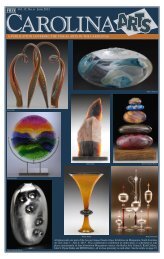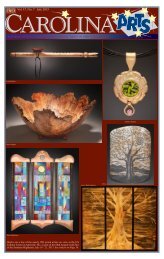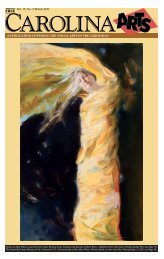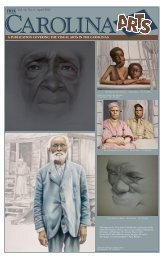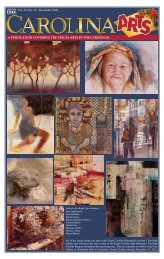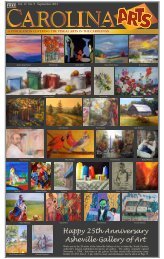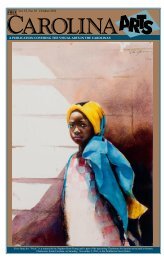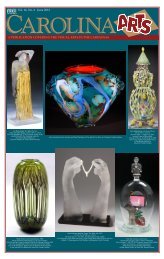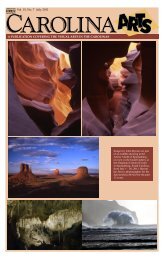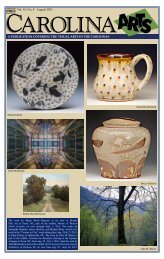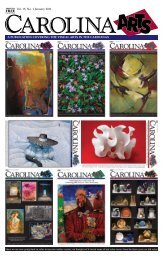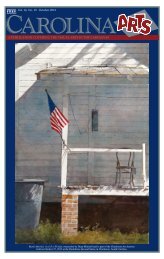NC Institutional Galleries - Carolina Arts
NC Institutional Galleries - Carolina Arts
NC Institutional Galleries - Carolina Arts
Create successful ePaper yourself
Turn your PDF publications into a flip-book with our unique Google optimized e-Paper software.
How About an Art Book<br />
continued from Page 13<br />
access that portrait photographers have long<br />
provided into the lives of their subjects.<br />
Each photographer prefaces his or her work<br />
with a brief description of the photographs<br />
and the experiences of working toward this<br />
collaborative project. In the afterword Paul<br />
E. Matheny III offers an assessment of how<br />
these portraits may be viewed by future<br />
generations and applauds the photographers<br />
for capturing “the soul of the state.”<br />
Participating photographers include: Jack<br />
Alterman, Jeff Amberg, Gayle Brooker,<br />
Vennie Deas-Moore, Brett Flashnick,<br />
Squire Fox, Andrew Haworth, Molly<br />
Hayes, Jon Holloway, Caroline Jenkins,<br />
Julia Lynn, Nancy Marshall, Phil Moody,<br />
Milton Morris, Stacy L. Pearsall, Blake<br />
Praytor, Ruth Rackley, Kathleen Robbins,<br />
Chris M. Rogers, Nancy Santos, Mark<br />
Sloan, Michelle Van Pary, Sam Wang, and<br />
Cecil Williams.<br />
Mark Sloan is the director and senior<br />
curator of the Halsey Institute of Contemporary<br />
Art at the College of Charleston School<br />
of the <strong>Arts</strong>. Sloan is an accomplished<br />
photographer and the author or coauthor of<br />
eight books.<br />
South <strong>Carolina</strong> novelist Josephine<br />
Humphreys is the author of Dreams of Sleep<br />
(winner of the 1985 Ernest Hemingway<br />
Award for First Fiction), Rich in Love (made<br />
into a major motion picture), The Fireman’s<br />
Fair, and Nowhere Else on Earth.<br />
Paul E. Matheny III is chief curator of art<br />
at the South <strong>Carolina</strong> State Museum.<br />
“The Palmetto Portraits Project reveals<br />
that we are both old and new. We are farmers,<br />
preachers, artists, tradesmen, taxidermists,<br />
roller-derby queens, factory workers,<br />
soldiers, scientists. We are eccentric and<br />
ordinary, salt-of-the-earth and miscreants,<br />
strugglers and dreamers. Our wild variety<br />
is our strength and our real wealth, as long<br />
as we recognize ourselves,” says Josephine<br />
Humphreys.<br />
ity traits. And hopefully, we can engage<br />
children to discuss and think about what<br />
positive traits they possess, such as bravery,<br />
kindness, courage and love. In other words,<br />
what makes them unique and special.<br />
After writing three books, I was fortunate<br />
to meet Zelda Ravenel, a graduate from<br />
Savannah College of Art and Design who<br />
majored in comic art. It was a perfect match<br />
as she captured the spirit and likeness of<br />
Cosmo and his “family” in her drawings.<br />
Although not published this year - this<br />
book is one of my all time favorites and<br />
might be yours too. The book is now in its<br />
second printing.<br />
Brian Rutenberg<br />
by Martica Sawin<br />
preface by Gregory Amenoff with an<br />
introduction by Walter Darby Bannard<br />
published by Radius Books<br />
11” x 11”, 164 pages, 85 color illustrations,<br />
ISBN: 978-1-93435-09-0<br />
Brian Rutenberg’s paintings reinvigorate<br />
and revitalize the medium. Raised in<br />
The next book is not on the market the South <strong>Carolina</strong> lowlands, Rutenberg<br />
yet - but will be soon. We’re including it has lived and worked in New York for the<br />
as the illustrator is our internet wiz - Zelda past 20 years. His work elicits a profound-<br />
Ravenel.<br />
ly visceral experience as he reinvests<br />
abstraction with a sense of spirituality.<br />
Cosmo the Dog With the Big Heart Influenced by the music of Glenn Gould<br />
and Celtic culture, as well as the paint-<br />
by Angie Blackburn<br />
ers Joan Mitchell and Hans Hofmann,<br />
Rutenberg draws on the landscape that he<br />
illustrations by Zelda Ravenel<br />
remembers from childhood, growing up<br />
between Pawley’s Island and Charleston,<br />
where the rivers and lakes join the ocean.<br />
The landscape, complex in its layers, has<br />
guided Rutenberg’s approach to composition<br />
and color. This volume is the first<br />
comprehensive presentation of his work.<br />
Brian Rutenberg was born and raised<br />
in Myrtle Beach, SC, and he received<br />
his BFA at the College of Charleston. He<br />
received an MFA in 1989 at the School<br />
of Visual <strong>Arts</strong> in New York City. He has<br />
shown his work at a variety of galleries<br />
and museums, including the Albright-<br />
Knox, the Boulder Museum of Contemporary<br />
Art, the American Academy of<br />
<strong>Arts</strong> & Letters Invitational, the Oakland<br />
Museum of Art, and Temple Bar Gallery<br />
in Dublin, Ireland. His work is held in the<br />
collections of the Yale Gallery of Art, The<br />
Butler Institute of American Art, Peabody<br />
Essex Museum and the Greenville County<br />
published by LAFing Dog Publishing Museum of Art, among others. He is<br />
currently represented by Forum Gallery,<br />
Angie Blackburn works as an editor in New York, NY, and Los Angeles, CA,<br />
at The Post and Courier newspaper in as well as by Jerald Melberg Gallery in<br />
Charleston, SC. She has been in love and Charlotte, <strong>NC</strong>.<br />
involved with words all her life.<br />
“Much to our surprise, Cosmo, a blackand-white<br />
Papillon, came into our lives in<br />
2007,” says Blackburn, adding. “He was a<br />
surprise and an inspiration. My husband,<br />
Smith, and I were surprised at how quickly<br />
we fell in love with him. And I was inspired<br />
to write a series of children’s books loosely<br />
based on the fact he is a very LARGE Papillon.<br />
The first is Cosmo the Dog With the Big<br />
Heart.”<br />
I tried to imagine what that might mean<br />
Fading # 3 by Brian Rutenberg<br />
for a dog family with several regular-size<br />
puppies and one very large puppy. The fact Martica Sawin has had a long career<br />
that our Cosmo has a heart-shaped mark- teaching art history and writing about<br />
ing on his side was a very intriguing idea as contemporary art in New York. She is the<br />
well. It sparked my imagination about what author of the seminal book, Surrealism in<br />
the heart could mean in terms of personal-<br />
continued above on next column to the right<br />
Page 14 - <strong>Carolina</strong> <strong>Arts</strong>, December 2012<br />
Table of Contents<br />
Exile and the Beginning of the New York<br />
School. Gregory Amenoff is a painter who<br />
is the recipient of numerous awards. He is<br />
currently the chair of the Visual <strong>Arts</strong> Division<br />
at Columbia University. Walter Darby<br />
Bannard is an internationally recognized<br />
abstract painter and writer about art whose<br />
articles have been published in Artforum<br />
and Art in America, among others.<br />
Editor’s Note: These books can probably<br />
be found in many art museum shops<br />
or book stores in North or South <strong>Carolina</strong><br />
or in some cases you can purchase them<br />
from the publisher or artists involved.<br />
Any of these books would make a great<br />
gift to someone you know or yourself.<br />
You could also think about purchasing one<br />
or several and donate them to your local<br />
arts group or organization for their reference<br />
library.<br />
For further information about USC<br />
Press visit (http://www.sc.edu/uscpress/).<br />
For further info about Schiffer titles visit<br />
(www.schifferbooks.com). For further<br />
info about the Cosmo book and when<br />
it will be available, visit (http://www.<br />
indiegogo.com/cosmothedog) and on<br />
Facebook at (https://www.facebook.com/<br />
CosmoTheDogBook). For further info<br />
about Brian Rutenberg’s book visit (http://<br />
brianrutenbergart.com/).<br />
REVISITED<br />
A Few Words From Down Under<br />
Editor’s Note: Judith McGrath contributed<br />
her writings about exhibits and events<br />
taking place in Western Australia to <strong>Carolina</strong><br />
<strong>Arts</strong> for about a decade. Although<br />
she was writing about events taking place<br />
thousands and thousands of miles away,<br />
they seemed relevant to what was going<br />
on here in the <strong>Carolina</strong>s. Her contributions<br />
were very popular when we first ran<br />
them and continue to be popular on our<br />
website’s archives. We’ve decide to revisit<br />
them from time to time.<br />
A Few Words from Down Under<br />
Who Says Who’s the Artist?<br />
by Judith McGrath, first run in our July<br />
2003 issue<br />
More often these days, when introduced<br />
to someone, we are expected to<br />
define what it is we do in order to explain<br />
who we are. We need a label, something<br />
to write in the box marked OCCUPATION<br />
on forms. Of all the labels available,<br />
Artist is the one most debated. We’ve all<br />
argued the difference between painters<br />
and artists, wood or metal workers and<br />
sculptors at one time or other. When it<br />
comes to Artists, what qualities distinguish<br />
the hobbyist or the amateur from the<br />
professional artist? And who makes that<br />
distinction, the individual or the rest of the<br />
world? The following art practitioners are<br />
real, I know them, their names have been<br />
changed to protect the innocent (me). Of<br />
the four, only one writes “Professional<br />
Artist” in the OCCUPATION box on<br />
forms. I invite you to read their accounts<br />
and guess which one it is.<br />
Ladies first. After the kids were grown,<br />
Cassie attended art college part-time, to<br />
ascertain the talent she already owned was<br />
legitimate. She has been making art all her<br />
life; her first memory is of drawing a picture.<br />
Although her family has priority over<br />
painting, when she’s on a creative roll or<br />
trying to resolve a problem with a composition,<br />
nothing comes between Cassie<br />
and her canvas. She creates bold colourful<br />
abstract paintings that always include<br />
a figure, enjoys experimenting with her<br />
medium and challenging her limits. Cassie<br />
has never approached a gallery nor held<br />
a solo exhibition, she doesn’t need to.<br />
Her large works sell well through Interior<br />
Design showrooms where they practically<br />
walk off the wall at premium prices, a fact<br />
that continues to surprise her.<br />
Then there’s Charles who died early<br />
this year at the age of 95. He taught art for<br />
awhile after graduating from a prestigious<br />
art school but soon discovered he wasn’t<br />
suited to the job. With a wife to support<br />
him, Charles retreated to his studio where<br />
he spent every day for almost fifty years<br />
pursuing his art. At the age of 86, Charles<br />
held his first solo exhibition in 1994,<br />
which I was able to give a good review.<br />
When I first met Charles at his second<br />
exhibition in 1996, he thanked me for my<br />
generous words and revealed I was the<br />
only one who ever wrote about him as an<br />
artist. His third and last exhibition in 2002<br />
was a sell out. Charles’ legacy is a sixroom<br />
studio filled with an amazing collection<br />
of drawings, prints and paintings.<br />
Soon after Dale graduated from art<br />
college he was offered a job as a part-time<br />
lecturer in the same school. He was a<br />
talented sculptor who won some big ticket<br />
public art commissions, held two successful<br />
solo shows in commercial galleries<br />
and received a government grant to put<br />
on a third, which received good reviews.<br />
Ten years ago, after securing a full-time<br />
teaching post, the one man shows ceased,<br />
however he has participated in a few<br />
mixed shows put on by a small collective<br />
of sculptors to which he belongs.<br />
Dale’s job is very demanding; in addition<br />
to teaching he is expected to coordinate<br />
community art projects secured by the<br />
college, and mentor students who participate.<br />
Little energy is left over for his own<br />
work, which has not progressed since his<br />
first show.<br />
Gerald earned a Masters of Fine Art<br />
from a reputable university art school<br />
more than twenty years ago. When he was<br />
the new young lion on the scene, he won<br />
prizes, exhibited work at good galleries in<br />
major cities around the country, participated<br />
in shows overseas and is represented in<br />
some prestigious collections. Gerald continued<br />
to develop and define his Minimalist<br />
style even as new cubs emerged, each<br />
taking their turn as leader of the pack.<br />
These days Gerald holds a solo exhibition<br />
every second or third year in a top gallery<br />
and participates in a few prize exhibitions.<br />
His high priced works continue to sell, if<br />
not like hotcakes. Gerald will sketch and<br />
paint every day when he finishes working<br />
at his full time job as a landscape gardener.<br />
As stated above, only one of the four<br />
fills in the OCCUPATION box on forms<br />
with Professional Artist. Can you guess<br />
who it is? It’s not Cassie; she’d never call<br />
herself an Artist, the tag is too ostentatious<br />
for her to wear. She would pen “Housewife”<br />
in the box with a certain flourish.<br />
Cassie will never stop making art, it’s<br />
always been a part of her; she is an Artist.<br />
However, since she doesn’t exhibit in galleries<br />
and hasn’t had a write up in an art<br />
journal, the art world considers her just a<br />
clever painter with a paying hobby. That’s<br />
fine by Cassie.<br />
Gerald wouldn’t write Artist either;<br />
he’d pen in “Landscape Gardener” on<br />
forms because that’s what pays the bills.<br />
The money earned in landscaping allows<br />
him to keep painting. And he does keep<br />
painting because he has to; he is an Artist.<br />
Meanwhile, because he exhibits in a gallery,<br />
gets decent reviews, has been written<br />
about in art journals and won prizes, gallery<br />
managers and collectors call Gerald a<br />
Professional Artist. Well they would, they<br />
have a vested interest.<br />
The late Charles would have left the<br />
box blank or written “Unemployed”. But<br />
Charles spent a lifetime exploring different<br />
techniques and perfecting his skill in<br />
a variety of artforms within the paramcontinued<br />
on Page 30



